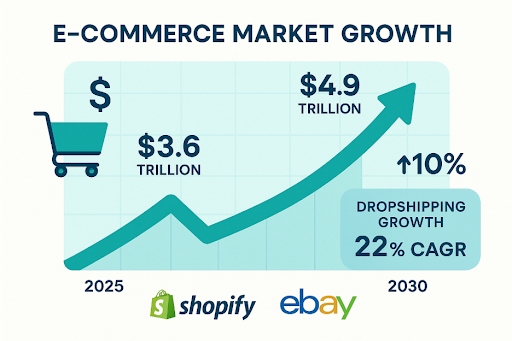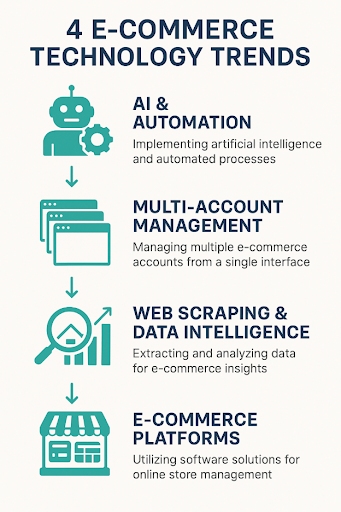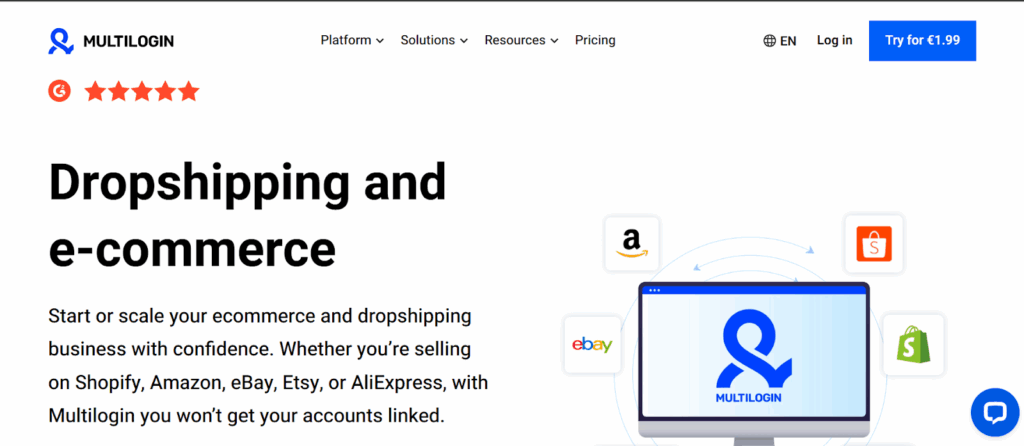Look, we’re not going to sugarcoat this —e-commerce has completely taken over. We’re talking $3.6 trillion in sales for 2025, heading straight toward $4.9 trillion by 2030 [1]. If that doesn’t make you sit up and pay attention, don’t know what will.
The wild part? Having a decent product and competitive prices used to be enough. Not anymore. The sellers crushing it right now are the ones who figured out how to use technology to work smarter (not harder, as they say).
This article is going to walk you through the tech trends that are making a difference in e-commerce—not the normal stuff, but the real tools people are using to win.
The Numbers Are Kind of Insane
Here’s what’s happening. E-commerce is growing so fast it’s almost ridiculous.
Dropshipping alone? Growing at over 22% every year, and experts think it’ll be worth multiple trillions by 2035 [2].
You can literally start a store today with barely any money upfront, which explains why Shopify, Amazon, and eBay are seeing thousands of new sellers every single day.

Sounds amazing, right? Well… yes and no. More opportunity means more chaos. Try managing three or four stores at once and you’ll see what we mean.
It gets messy really fast. And tracking what your competitors are doing when there are millions of other sellers? Good luck with that. Unless you’ve got the right tech helping you out, you’re basically flying blind.
The Tech That’s Actually Working (Not Just Hype)
There are four big technology trends separating the winners from everyone else. Let’s break them down.

AI and Automation (Finally Living Up to the Hype)
Remember when AI was just sci-fi stuff? Yeah, those days are gone. Now it’s running half of e-commerce behind the scenes.
Chatbots answer customer questions at 3 AM. Inventory systems somehow know you’re about to run out of stock before you do. Marketing platforms write product descriptions faster than you can say “conversion rate.”
But here’s where it gets interesting. The real magic happens when you connect all these pieces together.
E-commerce automation platforms can handle the boring stuff—processing orders, updating inventory, sending follow-up emails. This frees you up to actually think about growing your business instead of drowning in spreadsheets and customer service tickets. Fewer mistakes, faster operations, and you get your evenings back. Win-win-win.
Scaling Without Getting Your Accounts Banned

Image Source: https://multilogin.com/dropshipping-and-ecommerce/
Most successful sellers don’t stop at one store. They go all in—Amazon, eBay, Etsy, Shopify, wherever their customers hang out.
Smart move, except for one tiny problem: these platforms really don’t want you running multiple accounts. And their detection systems? Scary good.
Try managing several stores from the same computer and watch what happens. First, they get linked. Then suspended. Then permanently banned. Game over, thanks for playing.
This is where multi-account management tools basically saved the entire multi-store business model. They create completely separate browser environments for each account—different cookies, different browsing history, different everything. Each one looks like a totally different person to the platform’s detection algorithms.
Think of it like having five different computers, but you can control them all from one screen. Switch between your Amazon store, your eBay shop, your Etsy boutique—no risk of getting caught. For anyone serious about scaling, this tech went from “nice to have” to “absolutely essential” pretty much overnight.
Data Is Your Secret Weapon (If You Know How to Use It)
Millions of sellers fighting over the same customers. How do you stand out? Information. Specifically, knowing what your competitors are doing before everyone else figures it out.
Manual research is a joke at this scale. You can’t possibly check hundreds of competitor prices every day, track trending products across five platforms, and read through customer reviews—all by yourself.
You’d need to clone yourself about ten times. Price monitoring tools do this automatically, scraping data from competitor sites, marketplaces, and social media in real-time.
A shoe seller can track 500 competing products and adjust prices on the fly. A dropshipper can spot the next trending item the second it starts taking off.
This kind of competitive intelligence used to require hiring a whole research team. Now it runs in the background while you’re sleeping. Pretty wild when you think about it.
You Need a Solid Foundation (Or Everything Falls Apart)
Every successful e-commerce operation needs good infrastructure. I learned this the hard way. Dropshippers are juggling multiple suppliers, coordinating inventory across different platforms, trying to follow each marketplace’s weird rules. Spreadsheets work for about two weeks, then everything becomes a nightmare.
Dropshipping and e-commerce platforms give you a central command center—one dashboard to manage everything. They keep your accounts separate and secure, automate your workflows, and (this is important) make sure you’re not accidentally breaking platform rules. Whether you’re on Shopify, Amazon, eBay, or AliExpress, these platforms prevent the headaches that kill most new sellers before they even get started.
The Challenges Nobody Warns You About
Growing an e-commerce business comes with some predictable problems. Three big ones keep coming up.
- Platform compliance is a minefield. Amazon and eBay have super strict rules about multiple accounts. Their algorithms are constantly evolving. One mistake—just one—can mean permanent bans and all your revenue disappears. The solution? Technology that creates truly isolated environments, so each account looks completely independent to their detection systems. No shortcuts here.
- Operations get overwhelming fast. Scaling from one store to five or ten stores means you’re suddenly juggling inventory, orders, and customer service across multiple platforms. It’s chaos. Automation takes over the repetitive tasks, so you can focus on actual growth instead of getting buried under daily operations. Trust me on this one.
- Staying competitive is exhausting. Prices change constantly. New products pop up overnight. Customer preferences shift. Manual monitoring is literally impossible once you reach any kind of scale. Automated data tools keep you informed and responsive without the manual grind. Otherwise, you’re always playing catch-up.
What’s Coming Next (And It’s Pretty Cool)
The innovation train isn’t slowing down. Several emerging trends are about to shake things up even more.

- Livestream commerce is exploding. We’re talking $68 billion in the US by 2026 [3]. It’s like QVC met TikTok and had a baby. TikTok and Instagram are leading the charge, especially for fashion, beauty, and lifestyle stuff where personality and demonstration actually drive sales. People buy from people they like—turns out that still matters.
- Blockchain is moving from buzzword to actual business tool. Expected to hit $943 billion by 2032 [4]. It’s solving real problems around supply chain transparency and payment security. Customers want proof their luxury handbag or electronics are legit. Blockchain provides an unalterable record from factory to doorstep. Pretty hard to fake that.
- Mobile commerce is eating everything. Over half of all online transactions now happen on phones. If your site doesn’t work perfectly on smartphones, you’re basically leaving money on the table. And voice commerce through Alexa and similar devices is picking up steam too, which means sellers need to optimize for voice search. “Hey Alexa, order more dog food” is becoming normal.
Here’s the Deal
E-commerce growth isn’t slowing down anytime soon. The market is massive and getting bigger every day. But here’s the thing—success today takes more than a good product and decent prices.
Technology is what separates the winners from everyone else. AI automation, secure multi-account management, competitive intelligence tools—these aren’t just for big corporations with huge budgets.
They’re essential for any seller who actually wants to compete and win. The businesses embracing these tools are streamlining operations, making smarter decisions, and scaling without the usual growing pains that kill most businesses.
The future of e-commerce belongs to sellers who build on a foundation of powerful technology. The tools are already here. The opportunity is absolutely massive. The only real question is whether you’ll use them or get left behind.
References
[1] BigCommerce. (2025). Top Ecommerce Trends to Watch in 2025. Retrieved from https://www.bigcommerce.com/articles/ecommerce/ecommerce-trends/
[2] Research Nester. (2025). Dropshipping Market Size & Share | Forecast Report 2035. Retrieved from https://www.researchnester.com/reports/dropshipping-market/3705
[3] Statista. (2024). Livestreaming e-commerce in the U.S. – Statistics & Facts. Retrieved from https://www.statista.com/
[4] Statista. (2024). Blockchain – Worldwide. Retrieved from https://www.statista.com/






